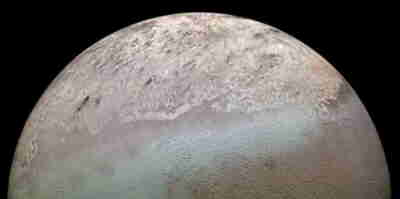| Triton the largest moon of Neptune

Triton was discovered by
British astronomer William Lassel, on October 10,
1846, and named for the son of Neptune, Greek god
of the sea.
| Facts and Figures |
| Diameter |
1,680 mi
(2,700 km) largest moon of Neptune |
| Mass |
2.14e=22
kg |
| Mean Distance from
Neptune |
571,336
mi (354,800 km) |
| Rotational Period |
-5.9
Earth days |
| Surface Temperature |
-391° F (-235° C) coldest
measured object in the Solar System |
| Atmospheric Pressure at
Surface (Earth=1 bar) |
0.000015
bars |
| Density (Water=1.0 grams
per cubic centimeter) |
2.066
grams per cubic centimeter |
 Triton
is the only large satellite in the Solar System
to circle a planet in a direction opposite to the
rotation of the planet. It's relatively high
density suggests that Triton has more rock in its
interior than the icy satellites of Saturn and Uranus do. The combination
of high density and retrograde orbit lead many
scientists to suggest that Triton may have been
captured by Neptune as it traveled through space
several billion years ago. Triton
is the only large satellite in the Solar System
to circle a planet in a direction opposite to the
rotation of the planet. It's relatively high
density suggests that Triton has more rock in its
interior than the icy satellites of Saturn and Uranus do. The combination
of high density and retrograde orbit lead many
scientists to suggest that Triton may have been
captured by Neptune as it traveled through space
several billion years ago.
The surface of Triton is marked by large
circular depressions. The depressions are
probably not impact craters, since they are too
similar in size and too regularly spaced. Their
origin may involve local melting and collapse of
the icy surface. Grooves and ridges cutting
across the landscape indicate fracturing and
deformation of Triton's surface, which is mostly
covered by nitrogen frost mixed with traces of
condensed methane, carbon dioxide, and carbon
monoxide. Voyager
2 images show active geyser-like eruptions
spewing nitrogen gas and dark dust particles
several miles into the atmosphere.
Because of its retrograde orbit, tidal
interactions between Neptune and Triton remove
energy from Triton, thus lowering its orbit. At
some very distant time in the future it will
either break up (perhaps forming a ring) or crash
into Neptune.

Saturn
Uranus
Voyager
Questions or comments about
this page?
|



